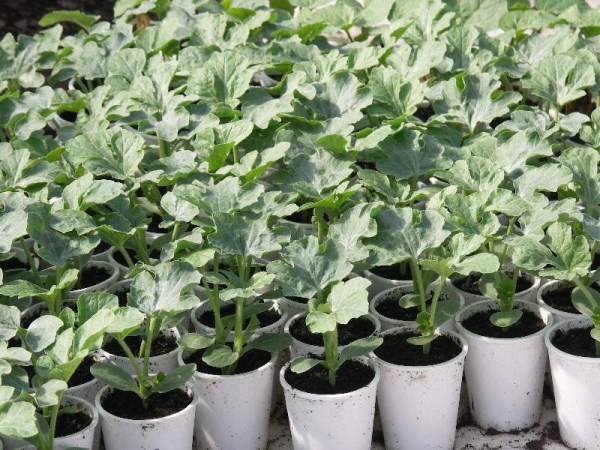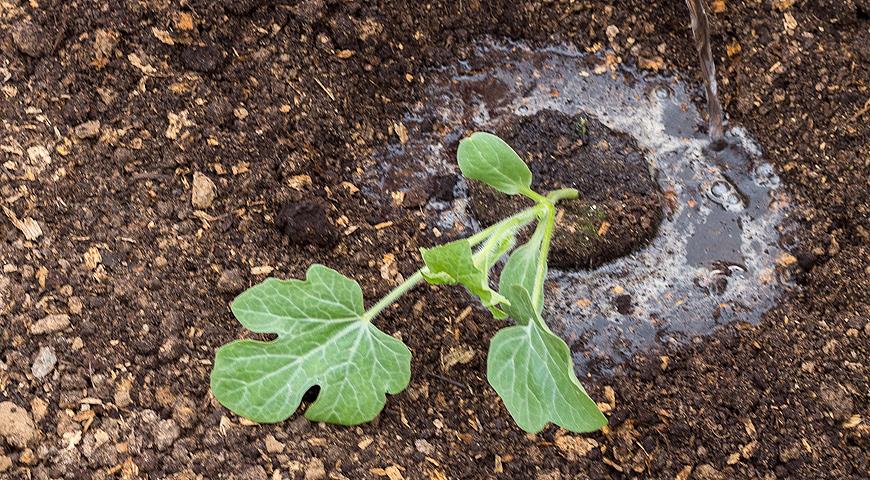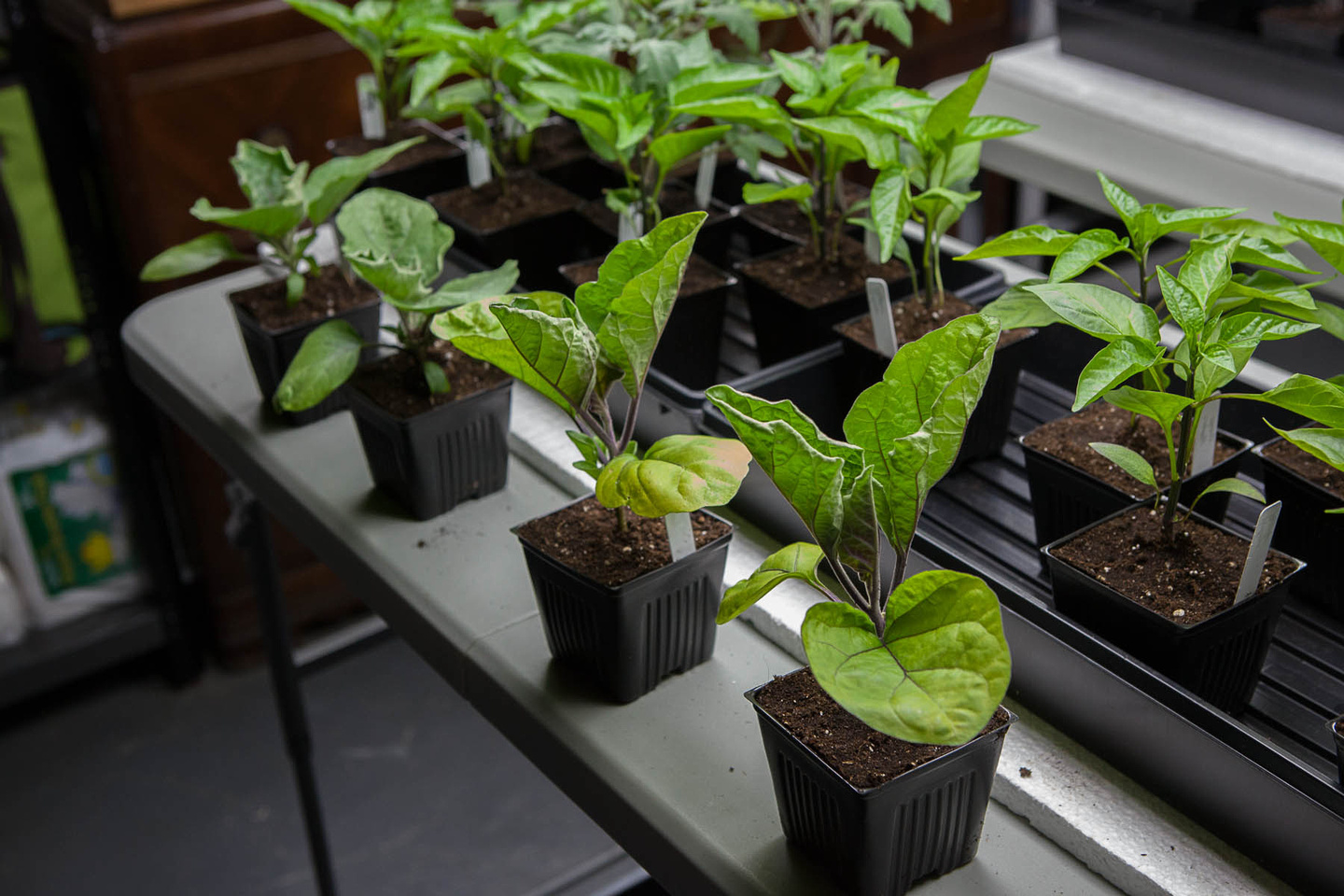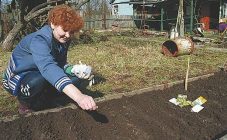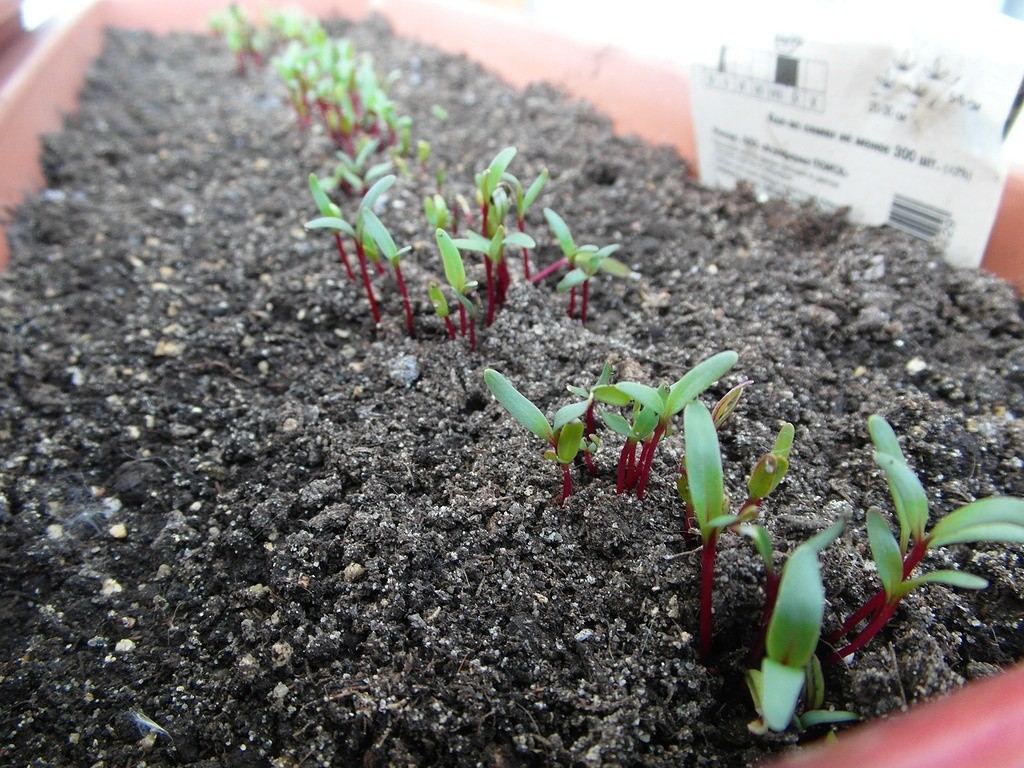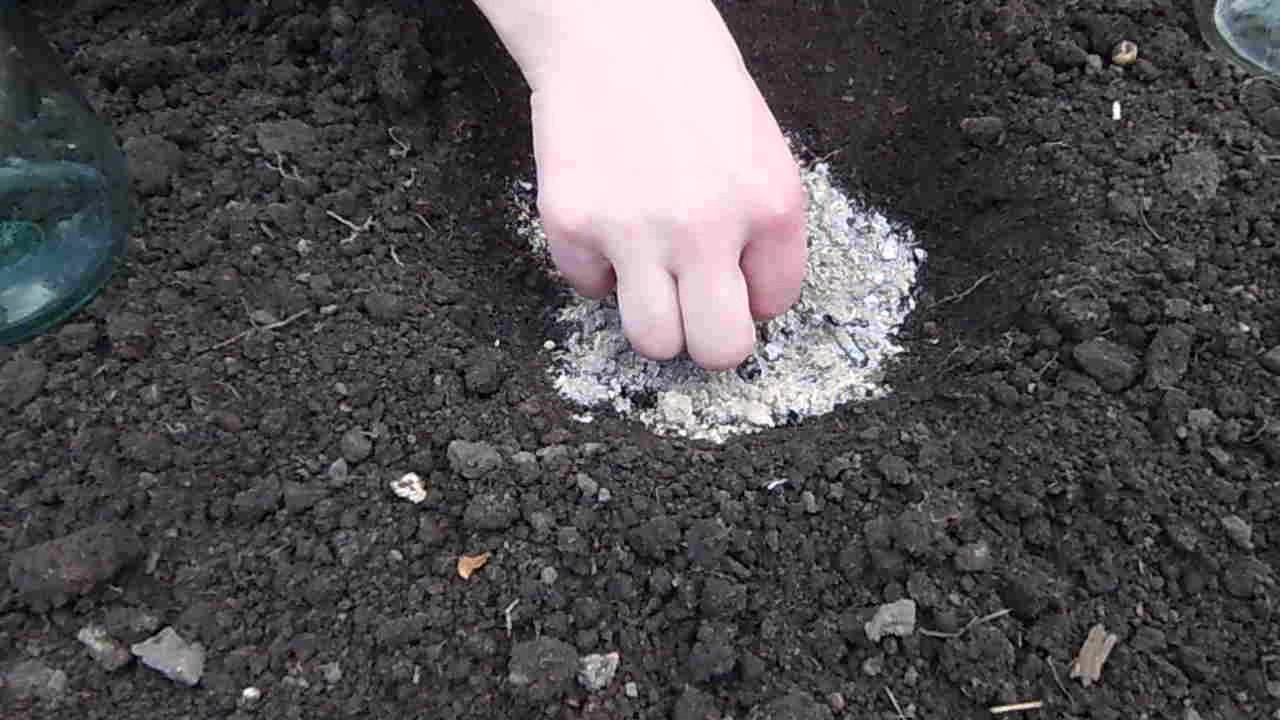Content:
Watermelon is one of the most delicious vegetable crops, belongs to the type of heat-loving and light-loving plants. Out of habit, many believe that it can only be grown in the southern regions, where only under the hot rays of the sun the watermelon ripens and turns out to be incredibly tasty and juicy. This opinion of most people is wrong and, knowing the necessary agronomic requirements for the ripening of this crop, you can get a big harvest even in mid-latitudes.
Conditions for successful cultivation of watermelons
The secret to growing a good harvest is to create favorable conditions for sowing watermelons and their growth:
- The landing site is selected in a sunny place, as protected as possible from the cold through wind. On an area located in the shade, the watermelon will not grow well;
- A plot of land intended for planting a watermelon crop should be located in a dry, not marshy area. The depth of the groundwater must be significant, since excess moisture has a detrimental effect on the root system of the plant, and it practically disappears;
- The ideal type of soil for watermelons is light, fertile sandy or sandy loam soil. In such a soil, the roots of the plant develop well and, therefore, the watermelon actively grows and ripens quickly;
- The acidity level of the soil should be between 6.5 and 7 Rn. On acidic soils, watermelon fruits will be small and may crack before ripening. If the acidity of the land on the proposed site is far from ideal, then it can be adjusted by agrotechnical methods;
- Crop rotation rates do not recommend planting a watermelon after melons and nightshade crops. The best predecessors that have a positive effect on the growth of a watermelon crop are alfalfa or wheat.
In the fall, the melon plot is necessarily freed from weeds and dug up. Organic fertilizer is applied to the ground at the rate of 4 to 5 kg per 1 m². For these purposes, rotted horse or cow manure is used, it is not recommended to use fresh organic matter, since in this case the resistance of the culture to dangerous fungal diseases decreases.
Favorable days for planting
You can enjoy delicious and juicy watermelon grown in your garden or summer cottage if you plant melon at a favorable time according to the calendar and in suitable weather. The phases of the moon have an important influence on melons and gourds. Therefore, most gardeners use the lunar sowing calendar to determine the date when to sow watermelons.
According to the basic rule of the sowing calendar, vegetables should be planted on the growing moon. For melons, this rule is not entirely correct: the time when it is best to plant watermelons in open ground with seeds comes closer to the full moon of our satellite. In this case, ripe watermelons will be large and juicy; when sowing melon seeds during the growing moon, there is a risk that the fruits will be small in size and with undeveloped pulp in the middle. There is also a threat of plant death at an early stage of development.
Auspicious days of the lunar calendar 2018:
- April: from 9 to 14, 22 and 28;
- May: from the 3rd to the 9th of May;
- June: June 2-6.
Experienced gardeners are advised to monitor the position of the moon in space in relation to the heavenly bodies.It is believed that when the Moon is in the sign of Scorpio or Aquarius, manipulations with seedlings lead to disappointing results, and the fruits will be tasteless and watery. Recommendations for determining the date when to plant watermelons and melons in open ground with seeds on favorable days of the lunar calendar can be attributed to useful advice, but it would be wrong to rely on the fact that the correct choice of the date guarantees a large and tasty harvest. The required success will ensure knowledge of the agrotechnical rules for growing and caring for melons and gourds.
Watermelon loves warm weather. Seeds planted in the soil germinate in 12-14 days at temperatures ranging from +16 to +18 degrees. At temperatures from +25 to +30 degrees, a watermelon seed germinates 7-8 days after sowing.
In our country, planting a watermelon from seeds directly into the soil is possible only in the southern regions. In the middle lane, melons and gourds are grown only in seedlings, and if the seeds are planted directly in the ground, the plant will not have enough light and heat for normal development.
Preparing seeds for planting in open ground
The embodiment of the cherished desire of every gardener to grow tasty and juicy watermelons begins with preparing the seeds for planting. Therefore, it is important to know how to plant watermelons in open ground with seeds. In order to get strong and healthy seedlings, seed material must be prepared:
- Watermelon seeds are heated in the sun or near a heating battery for 10 days. Heat treatment usually begins at the end of winter, in February;
- Accelerated warm-up method. The seeds are immersed for half an hour in hot water with a temperature of about + 55 degrees. This quick method of preparing seed is suitable for those gardeners who, for various reasons, did not have time to heat treatment in the early stages;
- Seed calibration. Seeds are sorted by size, separating large from small specimens. This mandatory procedure is necessary in order to plant sorted seeds in the ground separately. In this case, seedlings will develop normally, and small seedlings will not be oppressed by larger ones;
- Scarification of seeds. This additional procedure is recommended by experienced gardeners for melons grown in the middle zone of our country. The "nose" of the seed is rubbed with sandpaper, as a result of this damage it germinates faster;
- Disinfection. The fastest and most reliable result is obtained by keeping the seeds in a weak manganese solution for 15-20 minutes.
The seeds are slightly dried, after which they can be sown in the ground.
Seedling planting rules
The technology of planting watermelon seeds is quite simple. It is best to grow watermelon seedlings in a peat pot, in which case the delicate processes of the root system are not damaged during transplantation. In such a pot, seedlings are planted directly in it directly into the ground.
In order to save money, you can germinate seeds in disposable plastic cups or any other container. In this case, the grown seedlings are transplanted together with an earthen clod. For seedlings, you should choose small containers, their optimal height is 10 cm. The pot is filled with a humus-peat mixture, having previously stepped back from the edge of 3 cm. After that, the mixture is poured abundantly with water at room temperature. There is a rule how to plant watermelon seeds for seedlings: a seed is planted in the soil with a blunt tip down. The planted seeds are sprinkled with an earthy mixture and covered with foil. For quick germination, the pots are placed in a well-lit and warm place where there are no drafts.
Seedlings are watered as needed. Within a week, tiny sprouts appear in the pot. From this moment, the covering film is removed, and the germinated plant begins to grow freely.With a short spring day, it is necessary to provide the seedlings with additional lighting. This exercise reduces the risk of pulling seedlings. Then the seedlings are hardened. An ideal place for hardening is the glazed loggia of the apartment, where boxes with seedlings can be taken out for 10-12 days. So that the delicate roots do not rot when watering, it is important to prevent waterlogging of the earth.
After the stem of the plant has grown a little stronger, and the root system has become more developed, in the phase of appearance of 5-6 true leaves, the plant is ready for planting in open ground.
In order for the seedlings to develop well, it is necessary to apply fertilizers in the form of dressings:
- The first feeding is applied under the seedlings in 10-12 days. To do this, use a fermented mullein, which is diluted in water in a ratio of 1:10;
- The second feeding is done after 14 days. This time the composition of the fertilizer is more complex: an aqueous solution of a mullein in the amount of 1 liter. supplemented with superphosphate (50 g), potassium sulfate (30 g) and ammonium sulfate (15 g).
Before planting, the seedlings are watered abundantly with water and treated with an aqueous solution of Bordeaux mixture.
Transplanting seedlings begins early in the morning:
- First, planting holes are dug in the ground with a step of 70 cm to 1 meter and they are filled with 2 kg of compost;
- Prepared holes are watered abundantly with warm water;
- If small seedlings are planted in a peat pot, then in this case it is completely lowered into the hole. From another container, the plant is carefully removed and planted in an earthen mixture. Seedlings are planted in such a way that the bases of the cotyledonous leaves are in the ground, and the stalk is squeezed with soil;
- After planting the seedlings, the holes are sprinkled with dry earth and the plants are mulched with a thin layer of humus or dry sand.
This completes the planting of seedlings, and the watermelon beds are watered with warm water.
Further care
After planting, it is advisable to cover the watermelon beds. To do this, over the beds you need to make a wooden or wire frame, which is covered with PVC film or agrofiber.
Planting watermelons under a film on the garden bed creates a greenhouse effect, in such a microclimate the seedlings are actively developing. In such a shelter, small seedlings will be reliably protected from the cold wind and rain. The film cover is finally removed before flowering.
In addition to providing a protective shelter, watermelons need the following care:
- Pollination. If the weather is cloudy during the flowering period, it is recommended to carry out the pollination procedure manually. To do this, the stamens of one inflorescence touch the pistils of neighboring flowers. Roughly 40 days after such pollination, ripening of watermelons begins. In the regions of the middle lane, this natural function is performed by various insects;
- Formation... Gardeners of the northern regions often grow watermelons on trellises. To do this, it is necessary to form the plants into one stem. When the main stem reaches the top of the trellis, and several small watermelons are tied on the lashes of the plant, the top of the shoot is removed;
- Protective measures against pests. The most important enemies of melons and gourds - aphids, meadow moths, sprout flies, can cause great harm to the plant. If insects are found, plants can be saved with biologics such as Fitoverm. If there are a lot of insects, then you will have to use "chemistry" and treat the plants with chemical insecticides. For these purposes, Tantrek is used, recommended for combating melon aphids, or universal remedies: Fufanoe, Decis, Aktaru;
- Disease prevention... Watermelons can get sick with powdery mildew, anthracosis, pernosporosis, ascochitis. In order to prevent these harmful diseases that can destroy all the work of the gardener, the plants should be treated with the following agents: HOM, colloidal sulfur, Ordan and others.
Growing a watermelon in the middle lane is a risky undertaking and is suitable for ambitious gardeners. The reward for their patient and hard work will be a sugar and juicy watermelon grown in their own beds.
